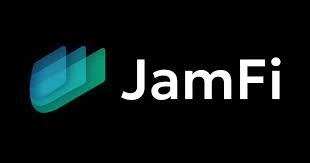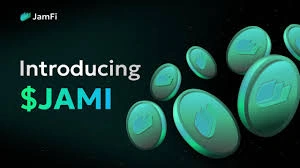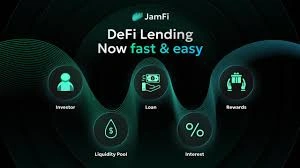JamFi (JAMI): DeFi Lending for Financial Inclusion in Africa
Table of Contents

Millions across Africa lack access to credit, but JamFi (JAMI) is changing that by marrying DeFi with mobile-first ecosystems like M‑Pesa. Built to empower borrowers through minimal verification (social metrics, mobile history), JamFi offers crypto-backed loans, while global lenders and token stakers can earn 30–50% annual returns through its collateralized pools. With over $400K raised in its seed round, and regulatory partnerships underway in Kenya and South Africa, JamFi is positioning itself at the intersection of real-world finance and decentralized innovation.
The $JAMI token fuels the platform, from lending, staking, and repayments to buyback-and-burn mechanisms built into its design. If you’re interested in a DeFi project that solves real inclusion challenges—not just price speculation—JamFi warrants attention. Let’s explore how its model works, what $JAMI offers, and what stakeholders should consider before joining.
For more insights and updates on the latest trends in cryptocurrency, be sure to check out our Nifty Finances platform, which serves as your gateway to smarter financial decisions in the digital economy.

What Is JamFi (JAMI) and How It Operates
JamFi, short for Jamii Finance, is a decentralized finance (DeFi) platform designed to make lending and borrowing more accessible, especially in underbanked regions such as Southern and Eastern Africa. Its mission is to bridge the gap between blockchain finance and real-world needs by offering lending services that integrate with familiar tools like M-Pesa, enabling users to borrow, lend, and transact more easily and affordably.
At the heart of JamFi is the $JAMI token, which powers transactions, staking, and incentives across the platform. The ecosystem is built with a focus on financial inclusion, aiming to support individuals and small businesses that have historically lacked access to traditional credit systems.
Decentralized Lending Made Simple
JamFi operates as a peer-to-peer lending platform using smart contracts and blockchain infrastructure to automate and secure lending processes. Users on the platform fall into two primary categories: borrowers and lenders.
Borrowers
JamFi makes it possible for users to apply for loans with minimal verification. Instead of requiring formal credit scores or bank histories, the platform considers alternative data sources like mobile usage, M-Pesa transaction records, and social metrics. This approach allows people who are often excluded from traditional banking systems to access small, short-term loans directly from their mobile phones.
Borrowers can choose between fiat-based loans in their local currency (such as Kenyan Shillings) or collateralized crypto loans, where they deposit tokens like $JAMI or ETH as security. Funds are often delivered via mobile money platforms, ensuring a smooth experience for users with limited access to formal banking.
Empowering Lenders with Rewards
On the other side of the platform are lenders and liquidity providers. These users can stake $JAMI tokens or contribute stablecoins to liquidity pools, enabling the capital that borrowers access. In return, lenders earn interest from repayments and receive a share of the platform fees generated from loan activity.
This model offers attractive yields, especially compared to traditional savings accounts or investment options available in the regions JamFi targets. Because all transactions are transparent and secured by smart contracts, lenders have visibility into the flow of funds and the performance of the lending pool.
Ecosystem and Token Utility
The $JAMI token plays a central role in JamFi’s ecosystem. It is used to pay fees, reward participants, and serve as collateral for loans. As the platform grows, the token is expected to gain broader utility in services such as payments, staking rewards, governance, and partnerships with merchants or cross-border payment providers.
JamFi also aims to extend its services beyond lending, creating a full financial ecosystem that includes decentralized payments, savings products, and real-world integrations. The goal is to empower users with tools that go beyond crypto, helping them participate in both local and global digital economies.
JamFi is redefining what accessible lending can look like in the age of decentralized finance. By combining blockchain technology with familiar mobile tools, it provides a practical solution for underserved populations in Africa and beyond. Through minimal barriers to entry, real-world utility, and strong incentives for participation, JamFi stands as a promising example of DeFi for financial inclusion.

Platform Mechanics & Lending Model of JamFi
JamFi is a decentralized finance (DeFi) platform built to deliver fast, low-cost, and transparent microloans in regions where access to traditional financial services is limited. Targeting underserved populations in Southern and Eastern Africa, JamFi blends blockchain technology with everyday tools like M-Pesa to offer a seamless borrowing and lending experience.
At the heart of JamFi’s model is a unique approach to collateralized lending, combined with community participation and token-based incentives. The platform is designed to operate autonomously through smart contracts while maintaining accessibility for users with limited banking history or credit access.
How Borrowers Access Loans
Borrowers on JamFi can apply for loans directly through the platform’s mobile-friendly interface. Unlike traditional banking systems that require extensive documentation, JamFi allows users to borrow using either:
- Cryptocurrency collateral, such as $JAMI or ETH
- Mobile payment history, particularly from services like M-Pesa
Borrowers typically lock up crypto assets at a collateralization ratio of approximately 130% to receive a loan. For example, if a borrower wants a $100 loan, they must deposit crypto assets worth at least $130. This over-collateralization protects the platform and lenders from price volatility in the crypto markets.
For users without crypto holdings, JamFi evaluates alternative data sources, such as mobile money usage, payment patterns, and social metrics. This enables unbanked or underbanked individuals to qualify for small fiat-based loans in their local currency, disbursed directly to their mobile wallet.
Yield Generation for Lenders and Stakers
JamFi is not only a borrowing platform—it also serves as an investment vehicle for lenders and liquidity providers. Anyone holding $JAMI or stablecoins can participate by:
- Staking tokens into the platform
- Providing liquidity to decentralized loan pools
As loans are repaid, interest payments and conversion fees (especially from fiat-crypto exchanges) are distributed back to these participants. This mechanism allows stakers and lenders to earn sustainable yields, often outperforming traditional savings accounts or fixed-income products.
The platform is structured so that earnings scale with loan demand. As more borrowers enter the ecosystem, lenders receive a greater share of interest income, fostering a healthy, self-reinforcing cycle of liquidity and growth.
Transparency and Smart Contract Automation
One of JamFi’s major advantages is its use of blockchain transparency and smart contract automation. Loan issuance, collateral management, repayment tracking, and interest distribution are all handled on-chain. This ensures:
- Real-time access to transaction data
- No need for intermediaries
- Tamper-proof loan records and borrower history
Because the system operates autonomously, loan decisions and payments happen faster than in traditional microfinance models, making JamFi especially suitable for quick, short-term loans in markets where financial delays can have a major impact.
Serving Underserved Regions
JamFi’s lending model is designed with emerging markets in mind. By leveraging existing tools like mobile payments and tailoring loan requirements to local realities, the platform brings affordable credit to people and communities long excluded from financial growth opportunities.
It combines the efficiency of DeFi with the real-world accessibility of mobile networks, offering a practical, scalable solution for financial inclusion.
JamFi’s platform mechanics and lending model represent a modern rethinking of micro-lending. With crypto and mobile-based collateral options, automated yield distribution, and fast loan approvals, it opens the door to accessible, decentralized finance for those who need it most.

The $JAMI Token Utility and Tokenomics
The $JAMI token is the core utility asset powering the JamFi decentralized finance (DeFi) ecosystem. Built to support financial inclusion in underserved markets, particularly across Africa, $JAMI enables a range of activities within the platform, serving as both a functional currency and an incentive mechanism.
With a fixed supply and clearly defined allocation model, $JAMI is designed to deliver sustainable long-term value for users, investors, and the broader JamFi community. From lending and staking to on-chain payments and community participation, the token is essential to the platform’s economic engine.
Fixed Supply and Distribution
The total supply of $JAMI is capped at 1 billion tokens, ensuring scarcity and preventing inflationary pressures over time. This supply is strategically allocated across multiple key areas to support ecosystem growth and platform stability:
- Liquidity Pools: A portion is dedicated to ensuring market liquidity and facilitating smooth trading.
- Investors and Early Supporters: Tokens are allocated to backers who provide initial funding and ecosystem support.
- Team and Advisors: Reserved for contributors to the platform’s development, with long-term vesting to align incentives.
- Marketing and Partnerships: Set aside for promotional campaigns, ecosystem integrations, and awareness programs.
- Airdrops and Community Rewards: Distributed to users through onboarding incentives and platform engagement.
This distribution strategy balances short-term adoption goals with long-term sustainability, giving both the platform and its users room to grow together.
Staking and Fee Sharing
One of the primary utilities of $JAMI is staking. Token holders can stake their $JAMI to earn a share of platform-generated fees from loan repayments, transaction processing, and token swaps. This provides a consistent yield opportunity for long-term participants.
In addition, JamFi uses a buyback-and-burn mechanism, allocating roughly 70% of all platform fees to buy $JAMI off the open market and permanently remove it from circulation. This reduces the total token supply over time, increasing scarcity and supporting price stability.
Stakers not only benefit from fee distributions but also the deflationary effects of regular buybacks, aligning the incentives of token holders with the long-term health of the platform.
Ecosystem Utility
Beyond staking, $JAMI is used across the JamFi platform in several practical ways:
- Lending Collateral: Borrowers can use $JAMI to secure loans on the platform.
- Interest Payments: Some loans or services may use $JAMI as a payment option for fees.
- On-Chain Payments: $JAMI can be accepted by merchants or used for peer-to-peer transfers within the ecosystem.
- Community Utilities: The token may grant access to exclusive features, reward programs, or premium borrowing limits.
As the ecosystem grows, additional utility is expected across dApps, wallet integrations, and real-world commerce.
Governance Potential
While JamFi currently focuses on lending and utility features, $JAMI may in the future support on-chain governance. Token holders could gain the ability to vote on platform upgrades, funding decisions, or policy changes, further decentralizing control and aligning the platform with its user base.
$JAMI is more than a token—it’s the engine behind JamFi’s inclusive DeFi model. With its fixed supply, staking rewards, buyback-and-burn system, and broad ecosystem utility, $JAMI is built to provide value, utility, and long-term sustainability for users, investors, and communities engaging with the JamFi platform.
Payment Integration & Real-World Use of $JAMI
One of the most powerful features of JamFi is its commitment to real-world usability. While many decentralized finance (DeFi) platforms remain focused solely on crypto-native functions, JamFi bridges the gap between blockchain and everyday life. Through direct payment integrations, practical partnerships, and a clear focus on financial inclusion, the platform ensures that the $JAMI token can be used not just for lending or staking but also for real-world purchases, payments, and services.
Integration with M‑Pesa: Fiat Meets Crypto
A major step toward mass adoption in Africa is JamFi’s integration with M‑Pesa, Kenya’s widely used mobile money platform. M‑Pesa plays a critical role in daily commerce and person-to-person transactions, particularly for individuals without access to traditional bank accounts.
By linking JamFi with M‑Pesa, users can:
- Convert fiat to crypto and back seamlessly
- Repay loans in local currency using mobile money
- Receive disbursed funds directly to their M‑Pesa wallets
This integration ensures that users don’t need to learn complex blockchain processes to benefit from decentralized finance. Instead, they can continue using the mobile tools they already trust, with JamFi providing the blockchain infrastructure quietly in the background. This lowers barriers to entry and enables broader participation across diverse income groups and demographics.
Retail and Sector-Based Partnerships
To expand the utility of the $JAMI token, JamFi has formed partnerships across key sectors in Africa’s economy, including:
- Retail: Merchants can accept $JAMI for in-store or online purchases, creating a local commerce loop where digital tokens have real purchasing power.
- Agriculture: Farmers and suppliers can access capital through JamFi and use $JAMI to buy equipment, fertilizers, or services from participating vendors.
- Education: Institutions may accept $JAMI for tuition payments, digital learning services, or student-related expenses.
- E-commerce: Online platforms are being integrated to allow $JAMI payments for digital goods, delivery services, and cross-border shopping.
These partnerships form the foundation for a usable digital economy, where $JAMI is not just a speculative asset but a functional medium of exchange in everyday life.
Everyday Transactions and Economic Growth
By supporting both digital and local payment infrastructures, JamFi enables users to:
- Spend borrowed or earned funds directly on necessities
- Reduce reliance on expensive remittance services
- Transact across borders with low fees and high transparency
This model not only improves access to financial tools but also stimulates local economies. Merchants receive more customers, students get easier access to education, and rural suppliers benefit from instant digital payments—all without traditional banking intermediaries.
As more people and businesses adopt JamFi, the network effect strengthens. The platform becomes more efficient, more useful, and more valuable, reinforcing its position as a cornerstone of everyday financial activity in the regions it serves.
JamFi’s real-world payment integration strategy—anchored by M‑Pesa and expanded through sector partnerships—sets it apart in the DeFi space. With the $JAMI token being used for lending, payments, and purchasing essential goods and services, the platform offers a practical solution to financial exclusion. By embedding itself in daily life, JamFi not only expands access to finance but also helps drive sustainable, inclusive economic growth.
At its core, JamFi is more than just a DeFi platform—it is a mission-driven project built to create lasting social impact. Focused on financial inclusion, especially in Africa’s underserved regions, JamFi aims to provide access to credit, income opportunities, and digital tools for individuals and communities left behind by traditional financial systems. Through blockchain technology and mobile accessibility, the platform empowers people to take part in the growing digital economy on their terms.
JamFi offers more than token speculation—it delivers functional financial accessibility in underserved African markets. Through its $JAMI token, JamFi merges DeFi mechanics with real-world lending, enabling borrowers to access credit using mobile data and lenders to earn legitimate returns. With collateralized loans, M‑Pesa integration, staking rewards, and buyback-burn resilience, it aligns with broader financial inclusion goals.
That said, this is still an early-stage ecosystem. Its success hinges on compliance approvals, token launch execution, mobile uptake, and real-world partnerships. For investors and impact-driven crypto users, JamFi represents a fusion of DeFi technology with ethical development finance, but with early risks. If this aligns with your vision of blockchain for good, JAMI might be a token worth watching as it evolves.